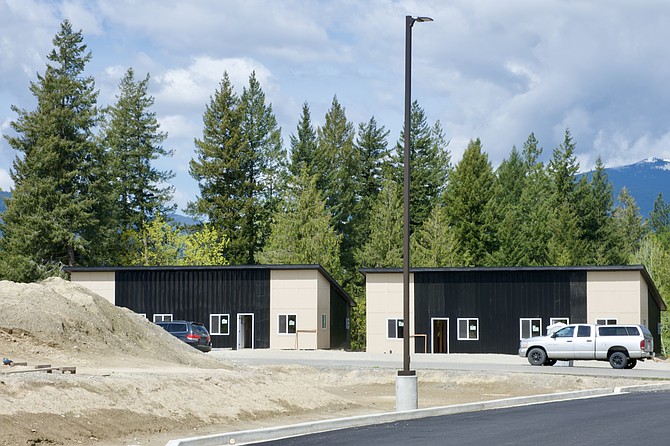The North Idaho growth predicament

Boundary County officials have lauded the work of some private developers who have expanded the affordable housing market in Bonners Ferry. Jim and Brenda Ball have built almost 230 units in the county, many of which are leased at below the county’s median rental cost. Construction for 16 single-story units on the South Hill is almost complete.
Coeur d’Alene, Sandpoint and Bonners Ferry — the administrative and cultural anchors of their respective counties — are all pursuing strategies to meet the persistent demand for affordable living in North Idaho.
High-density housing has consistently emerged as a solution to ease the pressure of accommodating growth.
On March 12, the Coeur d’Alene Planning and Zoning Commission unanimously recommended a zoning code revision to support the Coeur Terre project, a development that could include up to 2,800 housing units on the 438-acre site in western Coeur d’Alene.
On April 16, the Sandpoint City Council gave preliminary approval for a 57-unit townhome project on a 4.1-acre parcel near single-family homes and Forest M. Bird Charter School.
On April 17, the Bonners Ferry Planning and Zoning Commission recommended the rezoning of an 80-acre industrial lot near downtown Bonners Ferry to a mixed-use zone, which would allow for high-density townhomes and cottage homes, pending final approval May 20.
While these decisions align with the cities' comprehensive plans, they are also generally unpopular amongst residents concerned about preserving the historic, rural character of their communities.
In the Ridley Village Court townhome project in Sandpoint, for example, 52 of 56 public comments opposed the project.
Similarly, in Bonners Ferry, many locals disagree with the city’s latest approach to accommodating growth. According to the city’s 2023 Comprehensive Plan survey, 78% of respondents emphasized the importance of protecting historic neighborhoods from redevelopment, and many expressed concerns at the April 17 public hearing that the proposed industrial lot redevelopment into townhomes and cottage homes contradicts that objective.
“I’ve seen those types of homes built in Sandpoint and to me, it takes away completely from the community,” said one opposer.
But if Bonners Ferry doesn’t increase housing opportunities within city limits, some officials say urban development could spill into agricultural and forestry lands — a trend already seen in the Rathdrum Prairie, where over 15 square miles of rural land have transformed into Coeur d’Alene suburbs since the 1980s, according to satellite images.
Having recognized some of the drawbacks of continued high-density development, the Rathdrum City Council turned the North Idaho development trend on its head May 14, when it rejected the rezoning of the 127 acres of city property from industrial to mixed residential use for a 500-home subdivision project. The rezoning, like many other proposals throughout the region, faced strong public opposition, with almost 30 public comments at the hearing, the Coeur d'Alene Press reported.
Rathdrum City Councilor John Hodgkins, who made the motion to deny Hayden Homes’ request, said that public feedback reflects the need for Rathdrum’s city code, comprehensive plan and future land use map to be updated.
"What may keep Boundary County from experiencing the same level of urban sprawl as the Rathdrum Prairie is the much stronger presence of private industry in Rathdrum," said Jim Ball, a Bonners Ferry affordable housing developer.
“I don’t see a way out of meeting the housing demand, unfortunately,” said Boundary County Commissioner Ben Robertson. “Ideally, you have the densest housing within the city, and private industry willing to build it.”
In Post Falls, the Panhandle Affordable Housing Alliance has taken a new approach to providing affordable homeownership opportunities. PAHA partnered with city officials to lower permit fees, enabling the construction of deed-restricted homes for households earning between $75,000 and $126,000. These homes sell for $290,000 to $430,000.
“I think both single-family and multi-family housing developments are needed,” said Maggie Lyons, PAHA executive director. “Single-family is more palatable for neighbors. And the middle to upper-middle class want single-family, not townhomes. But land costs have soared, so high-density and multi-family ends up being the only viable way for developers to build housing.”
PAHA’s homes in Kootenai County — where the median housing cost is 36% higher than in Boundary County — are priced similarly to homes on Bonners Ferry’s South Hill, according to the Boundary County assessor’s database.
But Bonners Ferry already charges the minimum building permit fees allowed by the state, making the PAHA model hard to replicate, said Bonners Ferry Mayor Rick Alonzo.
“We don’t have that luxury,” he said. “A nonprofit can’t lower its profit margin.”
Boundary County’s permit fees are also among the lowest in the state, Robertson said.
The real expense lies in extending utility services like water and sewer, which are limited outside of the city. Boundary County ordinances favor growth near existing infrastructure, but most rural areas lack the public systems to support it — unless new taxing districts are formed by local communities.
With limited land and utilities, the 80-acre lot near downtown Bonners Ferry — already served by industrial-grade infrastructure — may ultimately be the city's best chance to accommodate the growth that seems inevitable.
“People like to keep things the way they are, but in order to sustain growth, you’ve got to do something different,” Alonzo said.










